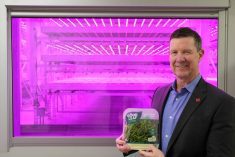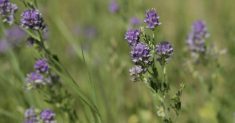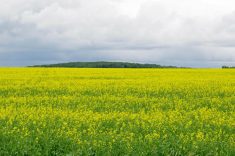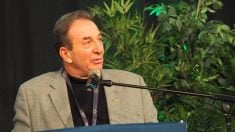“We need this committee to understand that growing alfalfa is fundamentally
different from growing annual crops.”
– JIM LINTOTT
Manitoba forage growers support an NDP bill to require new genetically engineered crops to undergo a marketing assessment, putting them at odds with canola and other crop producers who are opposed to it.
Kelvin Einarson, a director and secretary treasurer of Manitoba Forage Seed Association, told the Commons agriculture committee June 17 his group wasn’t opposed to GE crops, but it didn’t see any benefits for alfalfa growers from the technology.
Read Also

Manitoba sclerotinia picture mixed for 2025
Variations in weather and crop development in this year’s Manitoba canola fields make blanket sclerotinia outlooks hard to pin down
Alfalfa is the No. 3 field crop in Canada and export customers in Europe and elsewhere don’t want GE seed, hay or other products.
The committee is studying a private member’s bill from NDP Farm Critic Alex Atamanenko that would impose a market acceptance test on any GE variety.
The group is also opposed to testing of GE alfalfa because the GE trait would quickly spread into both cultivated and wild alfalfa stands, Einarson said. He noted that Roundup Ready alfalfa, the subject of court actions in the United States, offers no real benefit for alfalfa growers who would gain more from increased traditional breeding research.
Kurt Shmon, president of Imperial Seed (1979) Ltd. of Winnipeg, said his company has a thriving export business for alfalfa seeds that is dependent on products not being contaminated with GE genes. “Canada in the last five years has averaged in excess of $20-million worth of forage and turf seed exports into Europe, which has a zero tolerance towards GE traits.
“As demonstrated by Europe with the Triffid flax issue, when any amount of a seed from a non-approved event is identified, the buyer will cancel contracts and send the seed back to the seller, creating a loss for the company and the producers of this crop,” he added. “Currently, the contracts for all legume and grass seed species which are written between a European and Canadian company have clauses in them that state if any GMO species are found in the received seed, the seed will be returned to the seller and the contract cancelled.”
He also questioned the benefit of Roundup Ready alfalfa. “The potential market for it is very limited as 75-80 per cent of the seed sold for hay and pasture is mixed with another legume or grass, eliminating the advantage of applying Roundup to the field.”
Alfalfa is pollinated by honeybees and they can transfer pollen as far as five miles and maybe more, he said.
Another challenge with alfalfa is the seed can lie dormant in the soil for years before it starts to grow, he added. That trait makes it nearly impossible to contain GE alfalfa.
Jim Lintott, chairman of the Manitoba Forage Council, said most Manitoba forage growers are mixed farmers and understand the role of genetic engineering in field crops. They don’t oppose it for oilseeds and corn, but see no benefit in forage crops.
“We need this committee to understand that growing alfalfa is fundamentally different from growing annual crops,” he added. The market assessment requirement would “protect the alfalfa industry from the truly dangerous effects of introducing GE varieties that are not approved by their customers.”
The introduction of Roundup Ready alfalfa would also have a huge impact on organic growers and livestock producers, he said. “The organic industry, though small, is currently a $28-billion industry worldwide and a $2-billion industry in Canada.
“The organic industry is growing at an astonishing 19 per cent per year, so clearly this industry will be devastated by the presence of an uncontrollable GMO gene.”


















